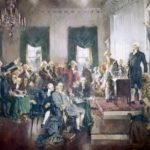“Federalism” is the word used to describe the Constitution’s system of dividing political power between the national government and the states. What is federalism and how does it work? Why did the founders build federalism into our constitutional system and what are the modern debates over federalism today? Explore the National Constitution Center’s Federalism learning module to learn more!
Strengthening Democracy in America
Strengthening Democracy in America is a collection of free courses featuring video interviews with noted scholars. These courses will deepen your understanding of the American political system and your rights and responsibilities in it. The first two courses provide a framework for understanding the history and development of the system. Subsequent courses focus on its strengths and weaknesses and means of enhancing the strengths and diminishing the weaknesses. The courses are open to anyone and can be completed at your own pace.
Flaws of the Electoral College System
In this activity, students will trace the history of the Electoral College through analysis of primary source documents from the elections of 1789, 1800, 1824, and 1988 to identify four flaws with the system. An examination of proposed and implemented reforms, including the 12th Amendment, will engage students in a discussion of modifying or abolishing the Electoral College.
James Madison at the Constitutional Convention

This video focuses on James Madison’s efforts to shape deliberation at the Constitutional Convention. His major goal was to replace the system of voluntary compliance of the states under the Article of Confederation with a system of law to compel compliance under the federal Constitution. Professor Jack Rakove explains Madison’s perspective that without such a system, the different interests within each state, coupled with diverse interests among the states, precluded effective governance.
Voting Rights in America Timeline
Supplement your students’ understanding of voting rights in the United States with this free downloadable timeline. This visual guide breaks down the history of voting rights across identities, and gives context to efforts to expand and limit voting access over time, through the lenses of our three branches of government and our federal system.
Civic Conversations
How do educators invest in productive, deep, and transformative dialogue in their classrooms? Civic Conversations is a collaboration between the Edward M. Kennedy Institute’s civic education programming and the community-building dialogic structure practiced by Essential Partners. Explore resources, activities, and lesson structures that support educators as they facilitate difficult conversations, create inclusive learning environments, raise complex discussions, and promote a safe space for students to consider their values and engage in their communities. Policy simulations at the Kennedy Institute reflect the wide range of issues that face our country today. Students debate the best way to reform our immigration system, consider the balance between privacy and security, and think about how to meet the challenge of climate change. As in the real Senate, it’s natural that students will disagree on the best approach to many civic issues. This collection of resources will support educators as they prepare to discuss civic issues, either in preparation for a Kennedy Institute field trip or to practice listening, sharing, and learning in the classroom.
Starter Kit: Checks and Balances Podcast
We exist in a delicate balance. Ours is a system designed to counterweight itself, to stave off the power grabs that entice even the fairest of us all. The U.S. government is comprised of humans, not angels, so each branch has the power to stop the other from going to far. The only catch being, of course, they have to actually exercise that power. In this episode, with the inimitable Kim Wehle as our guide, we learn what those checks actually are, and how the Executive, Legislative and Judicial branches (ostensibly) keep things democratic.
This short episode includes a one-page Graphic Organizer for students to take notes on while listening, as well as discussion questions on the back side.
Separation of Powers
Instead of placing authority in the hands of one person, like a king, or even a small group of people, the U.S. Constitution divides power. Power is first divided between the national, or federal government, and the state and local government under a system known as Federalism. At the federal level, the Constitution again divides power between the three major branches of our federal government: the legislative, the executive, and the judicial. Discover the battles of the branches in the National Constitution Center’s learning module.
27 Amendments Overview
There have been 27 amendments added to the Constitution since its ratification over 230 years ago. Each amendment has meant big changes to our system of government, and our nation as a whole. Discover the different amendments in the National Constitution Center’s learning module.
Article III: The Judicial Branch
Article III establishes the judicial branch of government, which is responsible for interpreting the laws. At the highest level, the judicial branch is led by the U.S. Supreme Court, which today consists of nine justices. In the federal system, the lower courts consist of the courts of appeals and the district courts. Learn more about judicial independence and judicial review in the National Constitution Center’s learning module.